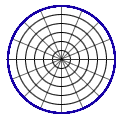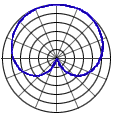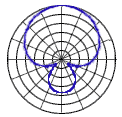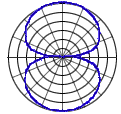Directional Properties
Every microphone has a property known as directionality. This describes the microphone's sensitivity to sound from various directions. Some microphones pick up sound equally from all directions, others pick up sound only from one direction or a particular combination of directions. The types of directionality are divided into three main categories:
- Omnidirectional
Picks up sound evenly from all directions (omni means "all" or "every"). - Unidirectional
Picks up sound predominantly from one direction. This includes cardioid and hypercardioid microphones (see below). - Bidirectional
Picks up sound from two opposite directions.
To help understand a the directional properties of a particular microphone, user manuals and promotional material often include a graphical representation of the microphone's directionality. This graph is called a polar pattern. Some typical examples are shown below.
Omnidirectional
 Captures sound equally from all directions.
Captures sound equally from all directions.
Uses: Capturing ambient noise; Situations where sound is coming from many directions; Situations where the mic position must remain fixed while the sound source is moving.
Notes:
- Although omnidirectional mics are very useful in the right situation, picking up sound from every direction is not usually what you need. Omni sound is very general and unfocused - if you are trying to capture sound from a particular subject or area it is likely to be overwhelmed by other noise.
Cardioid
 Cardioid means "heart-shaped", which is the type of pick-up pattern these mics use. Sound is picked up mostly from the front, but to a lesser extent the sides as well.
Cardioid means "heart-shaped", which is the type of pick-up pattern these mics use. Sound is picked up mostly from the front, but to a lesser extent the sides as well.
Uses: Emphasising sound from the direction the mic is pointed whilst leaving some latitude for mic movement and ambient noise.
Notes:
- The cardioid is a very versatile microphone, ideal for general use. Handheld mics are usually cardioid.
- There are many variations of the cardioid pattern (such as the hypercardioid below).
Hypercardioid
 This is exaggerated version of the cardioid pattern. It is very directional and eliminates most sound from the sides and rear. Due to the long thin design of hypercardioids, they are often referred to as shotgun microphones.
This is exaggerated version of the cardioid pattern. It is very directional and eliminates most sound from the sides and rear. Due to the long thin design of hypercardioids, they are often referred to as shotgun microphones.
Uses: Isolating the sound from a subject or direction when there is a lot of ambient noise; Picking up sound from a subject at a distance.
Notes:
- By removing all the ambient noise, unidirectional sound can sometimes be a little unnatural. It may help to add a discreet audio bed from another mic (i.e. constant background noise at a low level).
- You need to be careful to keep the sound consistent. If the mic doesn't stay pointed at the subject you will lose the audio.
- Shotguns can have an area of increased sensitivity directly to the rear.
Bidirectional
 Uses a figure-of-eight pattern and picks up sound equally from two opposite directions.
Uses a figure-of-eight pattern and picks up sound equally from two opposite directions.
Uses: As you can imagine, there aren't a lot of situations which require this polar pattern. One possibility would be an interview with two people facing each other (with the mic between them).
Variable Directionality
Some microphones allow you to vary the directional characteristics by selecting omni, cardioid or shotgun patterns.
This feature is sometimes found on video camera microphones, with the idea that you can adjust the directionality to suit the angle of zoom, e.g. have a shotgun mic for long zooms. Some models can even automatically follow the lens zoom angle so the directionality changes from cardioid to shotgun as you zoom in.
Although this seems like a good idea (and can sometimes be handy), variable zoom microphones don't perform particularly well and they often make a noise while zooming. Using different mics will usually produce better results.
Next Page: Microphone Impedance